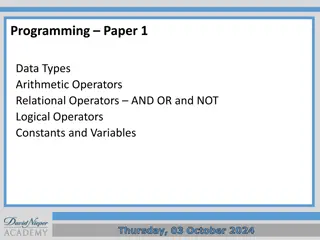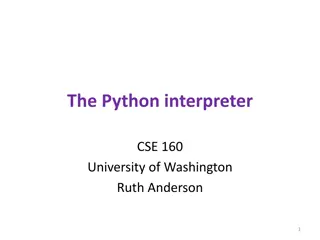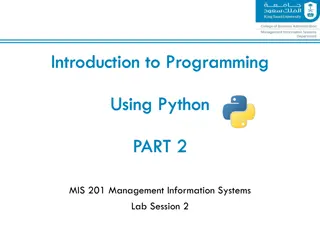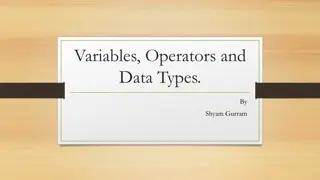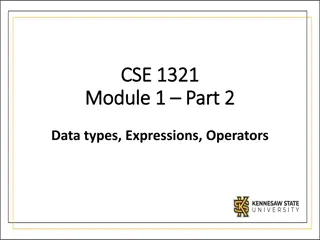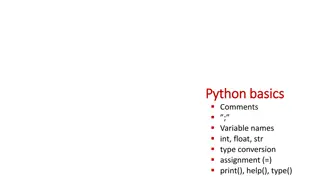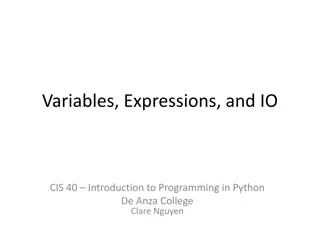Understanding Python Operators: Arithmetic, Comparison, and Assignment
Python language supports various types of operators such as arithmetic operators for addition, subtraction, multiplication, division, modulus, exponent, and floor division. It also includes comparison operators to check equality, inequality, greater than, less than, greater than or equal to, and less than or equal to. Furthermore, assignment operators allow assigning values and performing operations like addition, subtraction, multiplication, division, and modulus at the same time.
Download Presentation

Please find below an Image/Link to download the presentation.
The content on the website is provided AS IS for your information and personal use only. It may not be sold, licensed, or shared on other websites without obtaining consent from the author. Download presentation by click this link. If you encounter any issues during the download, it is possible that the publisher has removed the file from their server.
E N D
Presentation Transcript
Python Operators Mrs. Hiteshri Shirtavde Dept. of BSc(Comp.Sci) M D College, Parel
Python - Basic Operators Python language supports following type of operators. ? Arithmetic Operators ? Comparision Operators ? Logical (or Relational) Operators ? Assignment Operators ? Conditional (or ternary) Operators
Python Arithmetic Operators: Operator Description Example + Addition - Adds values on either side of the operator a + b will give 30 - Subtraction - Subtracts right hand operand from left hand operand Multiplication - Multiplies values on either side of the operator Division - Divides left hand operand by right hand operand Modulus - Divides left hand operand by right hand operand and returns remainder Exponent - Performs exponential (power) calculation on operators Floor Division - The division of operands where the result is the quotient in which the digits after the decimal point are removed. a - b will give -10 * a * b will give 200 / b / a will give 2 % b % a will give 0 ** a**b will give 10 to the power 20 9//2 is equal to 4 and 9.0//2.0 is equal to 4.0 //
Python Comparison Operators: Operator Description Example == Checks if the value of two operands are equal or not, if yes then condition becomes true. (a == b) is not true. != Checks if the value of two operands are equal or not, if values are not equal then condition becomes true. (a != b) is true. <> Checks if the value of two operands are equal or not, if values are not equal then condition becomes true. (a <> b) is true. This is similar to != operator. > Checks if the value of left operand is greater than the value of right operand, if yes then condition becomes true. (a > b) is not true. < Checks if the value of left operand is less than the value of right operand, if yes then condition becomes true. (a < b) is true. >= Checks if the value of left operand is greater than or equal to the value of right operand, if yes then condition becomes true. (a >= b) is not true. <= Checks if the value of left operand is less than or equal to the value of right operand, if yes then condition becomes true. (a <= b) is true.
Python Assignment Operators: Operator Description Example = Simple assignment operator, Assigns values from right side operands to left side operand Add AND assignment operator, It adds right operand to the left operand and assign the result to left operand Subtract AND assignment operator, It subtracts right operand from the left operand and assign the result to left operand c = a + b will assigne value of a + b into c c += a is equivalent to c = c + a c -= a is equivalent to c = c - a += -= *= Multiply AND assignment operator, It multiplies right operand with the left operand and assign the result to left operand c *= a is equivalent to c = c * a /= Divide AND assignment operator, It divides left operand with the right operand and assign the result to left operand c /= a is equivalent to c = c / a %= Modulus AND assignment operator, It takes modulus using two operands and assign the result to left operand Exponent AND assignment operator, Performs exponential (power) calculation on operators and assign value to the left operand c %= a is equivalent to c = c % a c **= a is equivalent to c = c ** a **= //= Floor Division and assigns a value, Performs floor division on operators and assign value to the left operand c //= a is equivalent to c = c // a
Python Bitwise Operators: Operator Description Example & Binary AND Operator copies a bit to the result if it exists in both operands. (a & b) will give 12 which is 0000 1100 | Binary OR Operator copies a bit if it exists in either operand. (a | b) will give 61 which is 0011 1101 ^ Binary XOR Operator copies the bit if it is set in one operand but not both. (a ^ b) will give 49 which is 0011 0001 ~ Binary Ones Complement Operator is unary and has the effect of 'flipping' bits. (~a ) will give -60 which is 1100 0011 << Binary Left Shift Operator. The left operands value is moved left by the number of bits specified by the right operand. a << 2 will give 240 which is 1111 0000 >> Binary Right Shift Operator. The left operands value is moved right by the number of bits specified by the right operand. a >> 2 will give 15 which is 0000 1111
Python Logical Operators: Operator Description Example (a and b) is true. And && Called Logical AND operator. If both the operands are true then then condition becomes true. (a or b) is true. Or || Called Logical OR Operator. If any of the two operands are non zero then then condition becomes true. not(a and b) is false. Not ~ Called Logical NOT Operator. Use to reverses the logical state of its operand. If a condition is true then Logical NOT operator will make false.
Python Membership Operators: In addition to the operators discussed previously, Python has membership operators, which test for membership in a sequence, such as strings, lists, or tuples. Operator Description Example in x in y, here in results in a 1 if x is a member of sequence y. Evaluates to true if it finds a variable in the specified sequence and false otherwise. not in x not in y, here not in results in a 1 if x is a member of sequence y. Evaluates to true if it does not finds a variable in the specified sequence and false otherwise.
Identity Operators in Python Identity operators are used to compare the memory addresses of two different objects. The two types of identity operators in Python are is and is not. Following table contains the description of these two operators, along with their respective examples. Example Operator Description is I = 20 J = 20 if(I is J): print ( I and J have same identity ) else: print ( I and J have not same identity ) Output I and J have same identity It returns true if both operands identities are the same; otherwise false. Is not I = 20 J = 230 if(I is not J): print ( I and J have not same identity ) else: print ( I and J have same identity ) Output I and J have not same identity It returns true if both operands identities are not the same; otherwise false.
Python Operators Precedence Operator Description ** Exponentiation (raise to the power) ~ + - Ccomplement, unary plus and minus (method names for the last two are +@ and -@) Multiply, divide, modulo and floor division * / % // + - Addition and subtraction >> << Right and left bitwise shift & Bitwise 'AND' ^ | Bitwise exclusive `OR' and regular `OR' <= < > >= Comparison operators <> == != Equality operators = %= /= //= -= += *= **= Assignment operators is is not Identity operators in not in Membership operators not or and Logical operators
Associativity operator ? Rules of Precedence and Associativity (1)Precedence rules decides the order in which different operators are applied. (2)Associativity rule decide the order in which multiple occurrences of the same level operator are applied. for example, ? a = i +1== j || k and 3 != x



